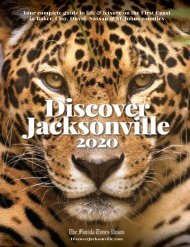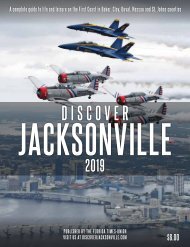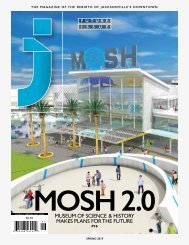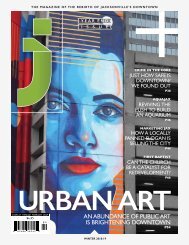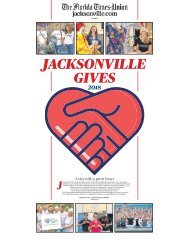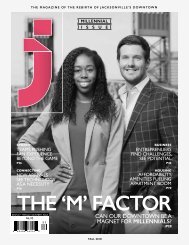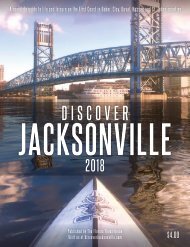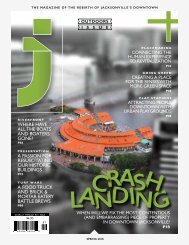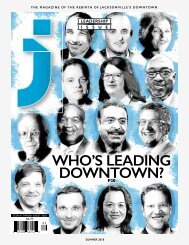J Magazine Winter 2019
You also want an ePaper? Increase the reach of your titles
YUMPU automatically turns print PDFs into web optimized ePapers that Google loves.
“Downtown is dead and we helped kill it,” Councilman I.G.<br />
Purser declared. “There is no major retail, no major attraction and<br />
no place to eat.”<br />
Thirty years after that admission, downtown Oklahoma City is<br />
thriving, home to major retail, restaurants, live music, hotels, attractions,<br />
parks and a population of several thousand living in new<br />
homes and apartments.<br />
A series of initiatives called Metropolitan Area Projects, a payas-you-go<br />
penny sales tax, led to creation of an NBA-ready arena, a<br />
riverwalk, minor league ballpark, library and a massive overhaul of<br />
downtown’s performing arts hall.<br />
But it took a bombing to get rid of the one-way streets.<br />
Long before Interstate 40 cut an eastwest<br />
path through the southern fringe<br />
of downtown, a pair of east-west streets,<br />
NW 5 and NW 6, were turned into oneway<br />
corridors. And when the interstate<br />
opened, NW 5 and NW 6 remained lightly<br />
traveled six-lane-wide one-way corridors.<br />
When Timothy McVeigh bombed the<br />
Alfred P. Murrah Federal Building on April<br />
19, 1995, he also left a huge crater in NW 5.<br />
Those wishing to build a memorial to the 168 killed and to those<br />
who survived proposed closing the street for good. City engineer<br />
Paul Brum, a powerful presence at City Hall, fought back, arguing<br />
maintaining the one-way corridor was a matter of public safety. He<br />
ended up being narrowly overruled by the city’s traffic commission.<br />
Brum’s next idea was to offset the loss of NW 5 as a one-way<br />
corridor by turning NW 4 into a one-way corridor. Brum correctly<br />
predicted downtown was about to go through a growth spurt, but he<br />
failed to understand such growth could occur without wide one-way<br />
corridors.<br />
“Anytime you have a two-way, you have people backed up making<br />
left turns,” Brum argued. “When you have a lot of traffic, then that<br />
creates problems.”<br />
The NW 4 conversion also went nowhere, and this second<br />
loss proved to be the beginning a long demise of one-way streets<br />
throughout downtown. The closed block of NW 5 was turned into a<br />
reflecting pool book-ended by the now iconic “Gates of Time” marking<br />
the time before and after the bombing.<br />
When NW 5 was turned into a two-way street, the city followed<br />
through with making NW 6 a two-way corridor as well. The predicted<br />
traffic jams did not follow.<br />
The Oklahoma City Council, no longer in lock step with the still<br />
powerful city engineer, requested city staff in 1999 to pursue conversion<br />
of more one-way streets to two-way traffic. That work did not<br />
proceed and wasn’t even started until a new public works director<br />
was hired in 2005.<br />
By this time, bond funding had been approved for the streetscaping<br />
of Walker Avenue, the same street targeted for a one-way conversion<br />
back in 1938. Designs, completed before Brum retired, called<br />
for the street to remain a one-way corridor.<br />
The street, Brum said, simply couldn’t function safely as a twoway<br />
street with one lane each way. Meanwhile, Cornett had begun<br />
looking at how to tackle one study after another that declared Oklahoma<br />
City was among the least fit in the country and most hostile<br />
for pedestrians.<br />
Cornett visited several times with Jeff Speck, a planner and author<br />
gaining acclaim for his book “Suburban Nation: The Rise of Sprawl<br />
and the Decline of the American Dream.” Those visits led to Cornett<br />
bringing Speck to Oklahoma City, where he was hired to compile an<br />
honest analysis of what ailed the city and how to fix it.<br />
Cornett brought Speck to Oklahoma City and in 2008 he was<br />
commissioned to do an analysis of the city’s streets and sidewalks<br />
and how to improve public health and walkability. The next Metropolitan<br />
Area Projects initiative passed by voters included funding to<br />
build up to 36 miles of sidewalks while also aggressively expanding<br />
the city’s trail system.<br />
Speck’s recommendations for downtown laid part of the premise<br />
for his next book, 2012’s “Walkable City: How Downtown Can Save<br />
America, One Step at a Time.”<br />
Not only were the one-way streets too wide, the lane widths were<br />
more appropriate for cars traveling at highway speeds. Hudson Avenue<br />
was especially bewildering, ranging from five to six lanes wide, a<br />
design dating back to when a shopping mall was planned (but never<br />
built) at the corner of Hudson and Sheridan Avenues.<br />
Speck showed the downtown street configurations to traffic engineers<br />
outside the state and their first response was to guess the street<br />
grid was set up for a downtown density and traffic volume comparable<br />
to Chicago or Manhattan.<br />
“They said this is a street network that will support three to four<br />
times the density it is handling,” Speck told the mayor and council.<br />
“Then you look at the traffic counts, and only a few carrying 10,000<br />
a day. And 10,000 cars a day is easily handled by a two-lane road.”<br />
Speck’s report coincided with announcement by Devon Energy<br />
that it was preparing to build a 50-story headquarters where city<br />
leaders had spent 20 years trying to turn into a suburban style “Galleria”<br />
mall.<br />
In an unusual move, the company’s co-founder, Larry Nichols,<br />
requested a $115 million tax increment finance (TIF) district —<br />
not for the headquarters but instead to make streets and sidewalks<br />
friendlier and safer for pedestrians.<br />
A lack of funding could no longer be used as a reason not to convert<br />
all one-way downtown streets and reduce lane widths. City engineers,<br />
however, still resisted and planned to retain short one-way<br />
stretches of Walker and Hudson Avenues claiming they were short of<br />
needed traffic lights even with the TIF funding.<br />
After some digging and questioning by The Oklahoman, city engineers<br />
acknowledged they had older traffic lights removed from<br />
streets improved as part of the Devon TIF project and could use<br />
those to finish the two-way conversions.<br />
Downtown Oklahoma City in <strong>2019</strong> is home to a network of streets<br />
that are all two-way corridors. The traffic nightmares never materialized.<br />
One of the most dramatic transformations is seen along NW 6,<br />
which was only converted to two-way traffic due to the loss of NW<br />
5 after the 1995 bombing, is returning to its roots as a neighborhood<br />
street.<br />
The street, however, is still five lanes wide and property owners<br />
are asking that it be put on a road diet. Similar development is taking<br />
place along NW 4, which is due to be narrowed this next year to<br />
make way for the city’s protected bike lane. Walker Avenue, which<br />
Brum said could not be converted due to risks of it becoming a traffic<br />
nightmare, is lined with shops, apartments. A streetcar has been<br />
added to the mix, along with scooters and bicycles.<br />
Contrary to predictions made along by some powerful voices<br />
over the history of Oklahoma City, the demise of one-way streets<br />
has only boosted the revival of a downtown that was once declared<br />
dead.<br />
Steve Lackmeyer, an award-winning reporter, columnist and<br />
author for the Daily Oklahoman newspaper, has covered Oklahoma’s<br />
conversion of downtown streets from one-way to two-ways.<br />
58<br />
J MAGAZINE | WINTER <strong>2019</strong>



